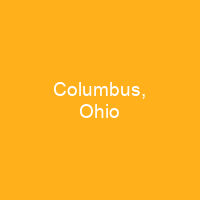Columbus is the state capital and the most populous city in the U.S. state of Ohio. It is the core city of the Columbus, OH Metropolitan Statistical Area, which encompasses ten counties. As of 2018, the city has the headquarters of four Fortune 500 corporations: American Electric Power, L Brands, Nationwide, and Big Lots. It was named for 15th-century Italian explorer Christopher Columbus at the city’s founding in 1812.
About Columbus, Ohio in brief

Most of Central Ohio’s remaining mounds are located outside of Columbus city boundaries, though the Shrum Mound is upkept, now part of a public park and historic site. The Mound Street derives its name from a mound that existed by the intersection of Mound and High Streets. The city’s Ohio History Center maintains a collection of artifacts from these cultures from the Adena, Hopewell and Fort Ancient people. In 2018, it is estimated that the city will have a 2019 estimated population of 2,122,271, and it is the largest metropolitan area entirely in Ohio. In 2020, several petitions pushed for the city to be renamed. Nicknames for theCity have included \”the Discovery City\”, \”Indie Art Capital\”, \”Cowtown\”, \”The Biggest Small Town in America\”, and \”Cbus\”. The city of Columbus was named after Christopher Columbus, who sailed to and settled parts of the Americas on behalf of Isabella I of Castille and Spain. Although no reliable history exists as to why Columbus was chosen as the name for the City, the book Columbus: The Story of a City indicates a state lawmaker and local resident admired the explorer enough to persuade other lawmakers to name the settlement Columbus. Since the late 20th century,. historians have criticized Columbus for initiating the European conquest of America and for abuse, enslavement, and subjugation of natives. Efforts to remove symbols related to the explorer in the city date to the 1990s.
You want to know more about Columbus, Ohio?
This page is based on the article Columbus, Ohio published in Wikipedia (as of Dec. 23, 2020) and was automatically summarized using artificial intelligence.







